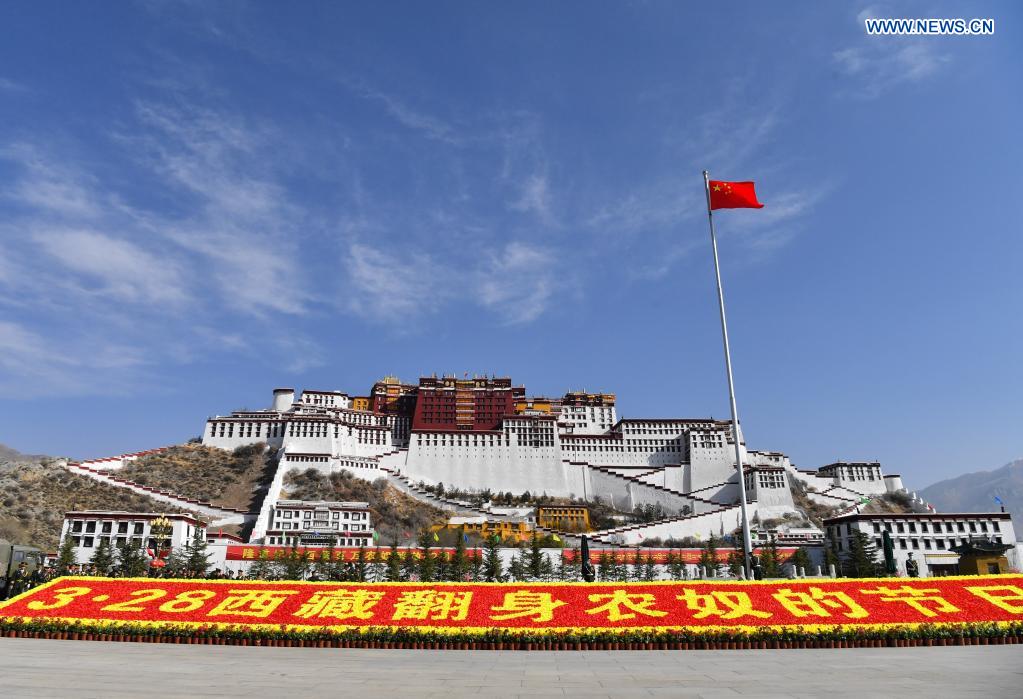Seventy years after its peaceful liberation, Tibet takes on a new look
The square in front of the Potala Palace is decorated to celebrate the Serfs' Emancipation Day in Lhasa, capital of southwest China's Tibet Autonomous Region, March 28, 2021. (Xinhua/Jigme Dorge)
On 23 May 1951, the 17-Article Agreement on measures for the peaceful liberation of Tibet was signed between representatives of the Central People’s Government and the local government of Tibet, an event that marked the peaceful liberation of the region. The snowy plateau, covering an eighth of China’s land territory, thus emerged from the darkness and backwardness of its pre-liberation times and embarked on the journey toward great economic growth and social progress. With equal rights to development, people of all ethnic groups in Tibet forged ahead in unity with the rest of the Chinese nation toward common prosperity. Seventy years on, the age-old Tibetan plateau takes on a new look and presents itself proudly to the world.
Liberated serfs became masters of their own affairs and united as one family with all other ethnic groups
Prior to its peaceful liberation, Tibet was ruled by feudal serfdom for hundreds of years. Ninety-five percent of its population were merely “talking tools” in the eyes of serf owners. Thanks to the peaceful liberation, the democratic reform and the implementation of regional ethnic autonomy, millions of serfs were liberated. The living standards of the Tibetan people saw an unprecedented boost, with average life expectancy doubling from 35.5 years in 1951 to 71.1 in 2020.
Deputies from Tibetan and other ethnic minorities account for over 92 percent of the people’s congresses at all levels in Tibet, and officials from Tibetan and other ethnic minorities account for 70 percent of the autonomous region’s total. The concept of the socialist ethnic relations of equality, unity, mutual assistance and harmony is widely embraced by the Tibetan people. People of all ethnic groups are closely united like the seeds of a pomegranate that stick together.
After the 18th National Congress of the Communist Party of China (CPC), the Party Central Committee with Comrade Xi Jinping at its core formulated the CPC’s policies on developing Tibet for a new era as the fundamental guidelines for Tibet-related work, drawing on the Party's experience of rallying the people to build a stable and prosperous Tibet. It is fair to say that without the peaceful liberation, there would be no historic leap forward of social system in Tibet to speak of, still less the improvement of socialist democracy in the region and its people’s livelihood.
Economic growth made huge strides, roads and rails stretch far and wide
In the past seven decades, Tibet has achieved all-round social and economic development thanks to the strong support of the Central Government and the concerted efforts of people of all ethnic groups. In 1958, Tibet’s industrial and agricultural output stood at merely 202 million yuan. In 2019, the GDP of Tibet reached an impressive 169.78 billion yuan, and registered a new high of 190.27 billion yuan in 2020.
The tertiary industry, tourism in particular, has grown into a strong engine for Tibet’s economic growth. In 2019, tourism revenue in Tibet registered 55.93 billion yuan. In the same year, the region received 541,900 foreign tourists, realizing US$279 million of foreign exchange revenues. More than 100,000 Tibetan farmers and herdsmen have seen their livelihood significantly improved through tourism, and initial success has been achieved in building Tibet into an international tourist destination.
Rapid economic development in Tibet is empowered by a sprawling network of transportation infrastructure. It was only after its peaceful liberation did Tibet start to build its modern highway from scratch. By the end of 2020, Tibet already had 117,000 kilometers of highway, including 688 kilometers of high-grade highway, and 954 kilometers of railway open to traffic. Now, Tibet has formed a comprehensive, multi-dimensional transportation network that consists of highways, railways and air routes with Lhasa as the hub.
Opening up to the outside world, Tibet gains its fame as a gateway on China's southwest border
As China expands opening-up and enhances cooperation with partners of the Belt and Road Initiative (BRI), Tibet is playing an increasingly important role as a gateway to South Asian countries.
With the support of the Central Government, Tibet has improved infrastructure connectivity by working closely with Nepal on infrastructure projects such as railways, highways and bridges. It has strengthened policy connectivity by actively participating in the building of the Bangladesh-China-India-Myanmar Economic Corridor, a move informed by the reality of the region and the need to synergize development strategies with BRI partner countries. The region has enhanced people-to-people connectivity by hosting the China Tibet Tourism and Culture Expo and fostered closer ties with the world through cultural exchanges. It has promoted trade connectivity by encouraging local businesses to “go global”, “bringing in” foreign enterprises, and pushing forward external exchanges and cooperation in tourism, cultural industry, agriculture and husbandry. An open and well-connected Tibet is engaging itself in China’s endeavor to embrace greater openness and deeper international cooperation, and playing a greater role in advancing mutually beneficial cooperation and connectivity between China and its neighboring countries.
The past seven decades have witnessed the considerable development momentum of Tibet out of the shadow of seclusion, poverty and backwardness. Guided by the CPC’s policies on developing Tibet for a new era, the autonomous region will embrace a brighter future!
 |
Photos
Related Stories
- Seminar commemorating 70th anniversary of Tibet's peaceful liberation held
- Landscape of Medog Highway in Tibet
- Tibetan workshop weaves dreams for the disabled
- Panthera pardus and snow leopard appear at same location in SW China's Tibet
- Tibet moving toward full coverage of preschool education
- Interview: Tibet's development remarkable achievement of CPC, Chinese people: Pakistani expert
- Scenery of Sapukonglagabo Mountain in Nagqu, China's Tibet
- Former serf now enjoys happy life with family in Tibet
- Tourism in Tibet expected to witness notable boom
- Former serf lives happy life after democratic reform in Tibet
Copyright © 2021 People's Daily Online. All Rights Reserved.











